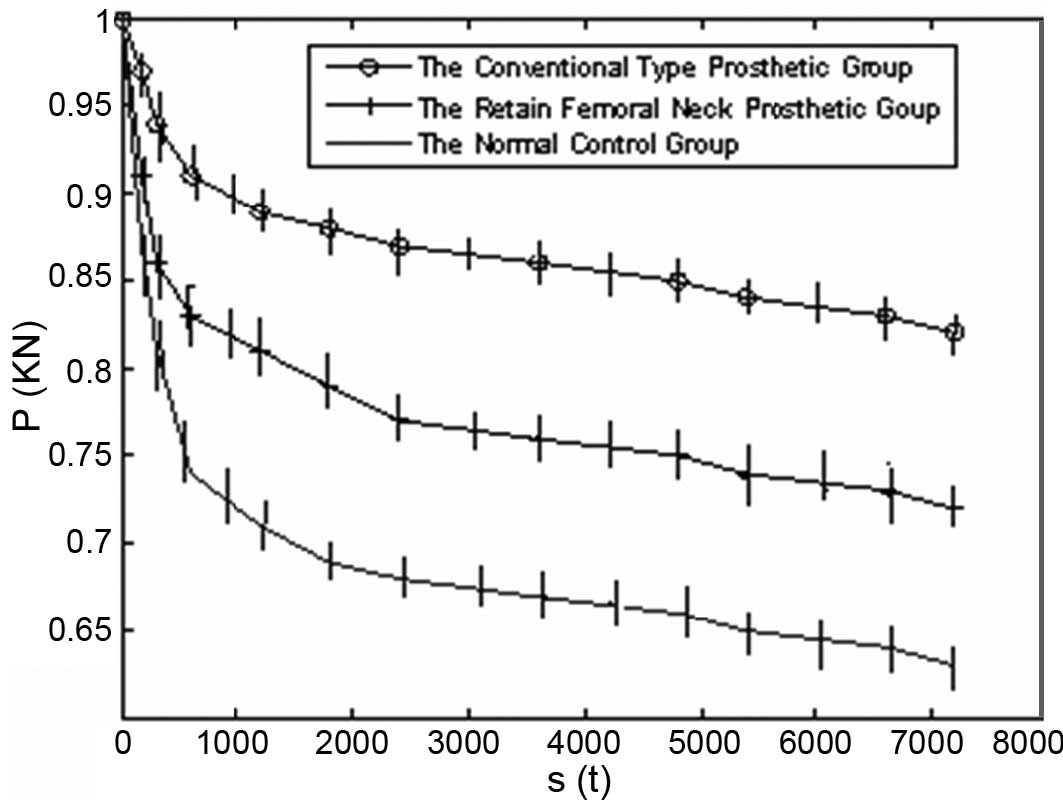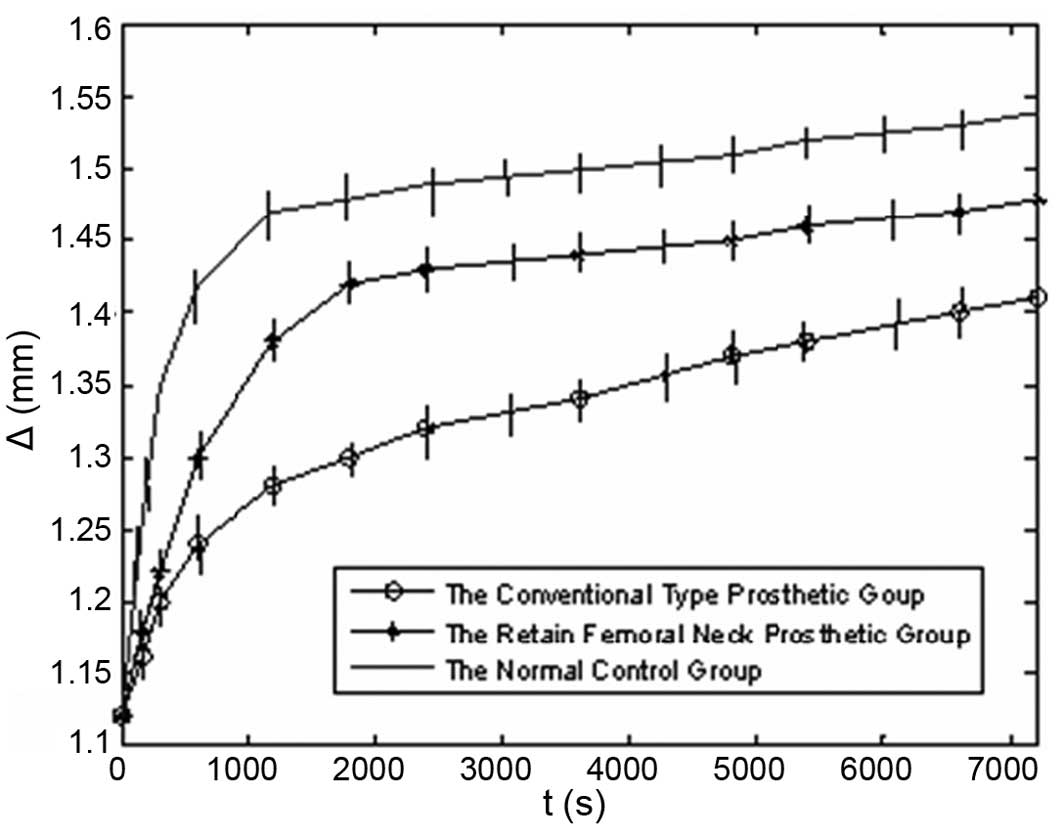|
1
|
Wang FC, Zhao SX, Quinoñez AF, et al:
Non-sphericity of bearing geometry and lubrication in hip joint
implants. J Tribol Trans ASME. 131:1–11. 2009.
|
|
2
|
Walker JA: Total hip replacement:
improving patients’ quality of life. Nurs Stand. 24:51–57.
2010.
|
|
3
|
Menschik F: The hip joint as a conchoid
shape. J Biomech. 30:971–973. 1997. View Article : Google Scholar : PubMed/NCBI
|
|
4
|
Mann KA, Gupta S, Race A, Miller MA,
Cleary RJ and Ayers DC: Cement microcracks in thin-mantle regions
after in vitro fatigue loading. J Arthroplasty. 19:605–612. 2004.
View Article : Google Scholar : PubMed/NCBI
|
|
5
|
Jiang HB and Ge SR: A contact mechanics
characteristic analysis of artificial acetabulum by finite element
method. Space Med Med Eng (Beijing). 20:223–226. 2007.(In
Chinese).
|
|
6
|
Mellal A, Wiskott HW, Botsis J, Scherrer
SS and Belser UC: Stimulating effect of implant loading on
surrounding bone. Comparison of three numerical models and
validation by in vivo data. Clin Oral Implants Res. 15:239–248.
2004. View Article : Google Scholar : PubMed/NCBI
|
|
7
|
Guo X, Fan YB and Li ZM: Biomechanical
analysis of wrist under axial static compressive force on
metacarpals. Space Med Med Eng (Beijing). 21:45–49. 2008.(In
Chinese).
|
|
8
|
Clark PA, Rodriguez A, Sumner DR, Hussain
MA and Mao JJ: Modulation of bone ingrowth of rabbit femur titanium
implants by in vivo axial micromechanical loading. J Appl Physiol.
98:1922–1929. 2005. View Article : Google Scholar : PubMed/NCBI
|
|
9
|
Zhao H, Barber GC and Liu J: Friction and
wear in high speed sliding with and without electrical current.
Wear. 249:409–414. 2001. View Article : Google Scholar
|
|
10
|
Angadji A, Royle M, Collins SN and Shelton
JC: Influence of cup orientation on the wear performance of
metal-on-metal hip replacement. Proc Inst Mech Eng H. 223:449–457.
2009. View Article : Google Scholar : PubMed/NCBI
|
|
11
|
Sidhu AS, Singh AP, Singh AP and Singh S:
Total hip replacement as primary treatment of unstable
intertrochanteric fractures in elderly patients. Int Orthop.
34:789–792. 2010. View Article : Google Scholar : PubMed/NCBI
|
|
12
|
Grimsrud C, Monzon RJ, Richman J and Ries
MD: Cemented hip arthroplasty with a novel cerclage cable technique
for unstable intertrochanteric hip fractures. J Arthroplasty.
20:337–343. 2005. View Article : Google Scholar : PubMed/NCBI
|
|
13
|
Yoshimine F: The safe-zones for combined
cup and neck ante versions that fulfill the essential range of
motion and their optimum combination in total hip replacements. J
Biomech. 39:1315–1323. 2006. View Article : Google Scholar : PubMed/NCBI
|
|
14
|
Antekeier SB, Burden RL Jr, Voor MJ and
Roberts CS: Mechanical study of the safe distance between distal
femoral fracture site and distal locking screws in antegrade
intramedullray nailing. J Orthop Trauma. 19:693–697. 2005.
View Article : Google Scholar : PubMed/NCBI
|
|
15
|
Lin J, Lin SJ, Chen PQ and Yang SH: Stress
analysis of the distal locking screws for femoral interlocking
nailing. J Orthop Res. 19:57–63. 2001. View Article : Google Scholar : PubMed/NCBI
|
|
16
|
Arabmotlagh M, Pilz M, Warzecha J and
Rauschmann M: Changes of femoral periprosthetic bone mineral
density 6 years after treatment with alendro-nate following total
hip arthroplasty. J Orthop Res. 27:183–188. 2009.PubMed/NCBI
|
|
17
|
Nogler M, Polikeit A, Wimmer C, Brückner
A, Ferquson SJ and Krismer M: Primary stability of a robodoc
implanted anatomical stem versus manual implantation. Clin Biomech
(Bristol, Avon). 19:123–129. 2004. View Article : Google Scholar : PubMed/NCBI
|
|
18
|
Halley D, Glassman A and Crowninshield RD:
Recurrent dislocation after revision total hip replacement with a
large prosthetic femoral head. A case report. J Bone Joint Surg Am.
86:827–830. 2004.PubMed/NCBI
|
|
19
|
Bevill SL, Bevill GR, Penmetsa JR,
Petrella AJ and Rullkoetter PJ: Finite element simulation of early
creep and wear in total hip arthroplasty. J Biomech. 38:2365–2374.
2005. View Article : Google Scholar : PubMed/NCBI
|
|
20
|
Dudda M, Gueleryuez A, Gautier E and
Roeder C: Risk factors for early dislocation after total hip
arthroplasty: a matched case-control study. J Orthop Surg (Hong
Kong). 18:179–183. 2010.PubMed/NCBI
|
|
21
|
Sakagoshi D, Kabata T, Umemoto Y, Sakamoto
J and Tomita K: A mechanical analysis of femoral resurfacing
implantation for osteonecrosis of the femoral head. J Arthroplasty.
25:1282–1289. 2010. View Article : Google Scholar : PubMed/NCBI
|
|
22
|
Beulah P, Sivarasu S and Mathew L: Design
optimization of skeletal hip implant cross-sections using
finite-element analysis. J Long Term Eff Med Implants. 19:271–278.
2009. View Article : Google Scholar : PubMed/NCBI
|
|
23
|
Davis ET, Olsen M, Zdero R, Papini M,
Waddell JP and Schemitsch EH: A biomechanical and finite element
analysis of femoral neck notching during hip resurfacing. J Biomech
Eng. 131:0410022009. View Article : Google Scholar : PubMed/NCBI
|
|
24
|
Fouad H: In vitro evaluation of stiffness
graded artificial hip joint femur head in terms of joint stresses
distributions and dimensions: finite element study. J Mater Sci
Mater Med. 22:1589–1598. 2011. View Article : Google Scholar
|

















